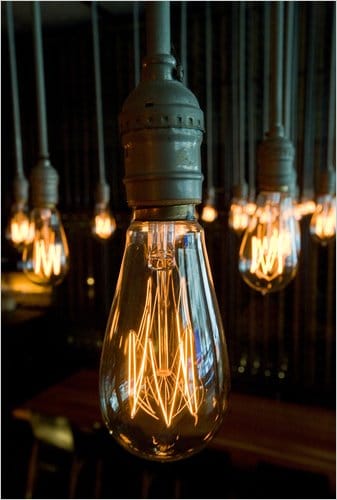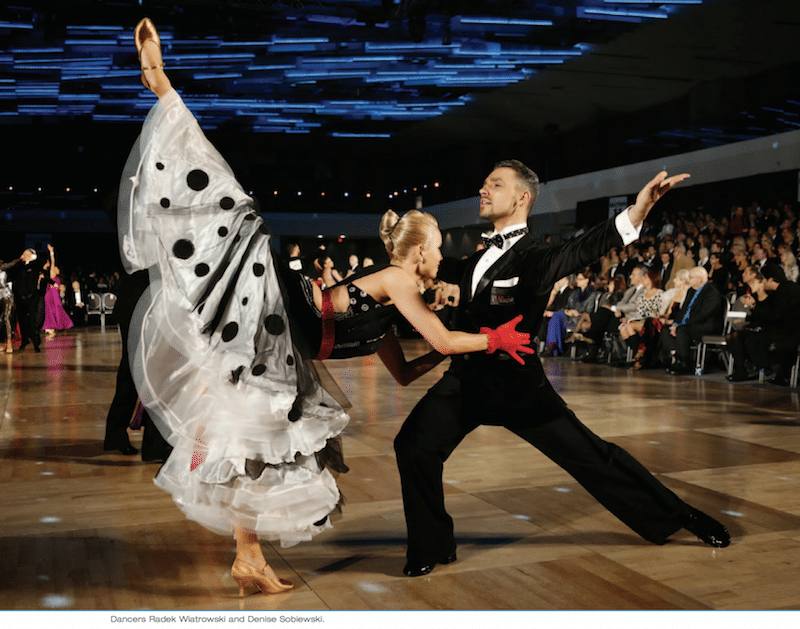
A New York Times article posted last week brought up an interesting topic – antique incandescent lamps, the old Edison style filaments, being used in restaurants and other places. The article brought up some interesting points, and had lots of interesting comments from people like Noah Horowitz, Ken Friedman, and Charlie Palmer. Check out this comment from Noah Horowitz, from the article:
“It boggles the mind that in these times of economic hardship and interest in environmental sustainability that restaurant owners would choose the light bulb that uses 5 to 10 times more power than the other bulbs on the market,” Noah Horowitz, a senior scientist at the environmental group, wrote in an e-mail message. “You can’t on the one hand brag how green you are by serving organic beer and locally grown produce while you are lighting your business with the least efficient light bulbs available in the world.”
You know the lamp they’re talking about? The Edison filament?
I’m a huge supporter of energy advocacy. HUGE. I love LEDs, period. I do hate CFLs, mostly because they look like total crap and are filled with Mercury. I love solar power, wind power, and other forms of sustainable energy production. I am always looking for new ways to help the LED industry grow in tune with my industry, lighting design. In the future, I see LED sources becoming the next light source in mass usage, and eventually they’ll be as cheap as incandescent lamps are now.
What really gets me kinda frustrated at critics of incandescent lamps is that most of them aren’t lighting designers, but since everyone else likes to bash incandescent lamps, critics hop on the blame game of incandescent lamps just because they won’t find much opposition. Incandescent lamp critics, do you just feel good to criticize because most people will agree with you? It’s true that it’s not an efficient source – but how many are you still using in your houses, where no one can see what you do on your own time?
Yeah. That’s what I thought.
In the case of these old Edison-style filaments, I think that if critics knew what exactly they were criticizing and WHY designers are using these old inefficient lamps, the critics might have more of an understanding of what they’re criticizing. In this case, I view this subject like iceberg lettuce – sure it has about no nutritional value, but lordy, people love it. Why? Well, it’s cheap, it has its place, and, well, it’s cheap. In the case again of these Edison lamps, lighting designers are using them to get an atmosphere that most LEDs cannot recreate, and certainly not by a fluorescent lamp. Charlie Palmer said that these old incandescent Edison lamps are twenty years ago, and Ken Friedman said “no exposed bulbs!” Well, why? Is it because you’re worried about energy consumption? Is it because you’re worried about people commenting on energy consumption? That doesn’t really seem like a good reason to me to criticize something that you just might not understand.
Now before you call me a troglodyte or some other important people word that you feel better using in order to insult a critic of critics, as a lighting designer, I have a problem being told that incandescent lamps have to be banned. What that says to me is that you don’t think that lighting designers can effectively utilize the light from incandescent lamps, so you have to go ahead and make people believe that they’re just the worst thing since the electric chair. I just have to simply say “BS.” You can tell me how to do my job when you’re better at it than me.
I have a hard time believing that the best next step for improving our worldwide use of electricity is to ban the incandescent lamp. Before you make huge claims like trashing decorative use of incandescent lamps, you should criticize our nation’s electrical grid, the development of Smart Meters, and the fact that energy companies make it nearly fiscally impossible for homeowners to put solar panels on their house in a financially effective way.
The almighty dollar stands in the way of effective and revolutionary changes to the way we light. I think that sucks. Next thing we know, fellow lighting designers, is that we’re not gonna be able to use HPLs, BTNs, FELs, or any other incandescent lamp because people other than lighting designers think they aren’t good for us.






Also in almost every installation of these lamps that I have personally seen, they are dimmed over 80%. They are using very very low amounts of power. Just because it says “60watts” doesnt mean that it will consume that once you dim it down.
Just to split hairs, the FEL is a highly inefficient lamp design and there are much better options (lower wattage and more output) for the older fixtures designed for FEL’s. But maybe that too is along the same lines as the “carbon filament” argument presented in this post, as some designer might want the light from an FEL. However, for institutions across the nation, finding better alternatives to the FEL is a smart move.
Great article Jim, Preach it brother. I have had this argument with individuals on more than one occasion in the past few years. It is a very frustrating topic indeed.
I totally respect your perspective and your passion on this topic, Jim. Certainly, the premise of an incandescent ban can change when you look at it from the perspective of a lighting designer v. the perspective of a homeowner (who isn’t a lighting designer, of course). It’s easy for homeowners to reach for the 99 cent 75W bulb the next time a light bulb burns out without thinking about the energy it will consume. It’s cheap, it’s on the shelf, it’s what needs replaced, done. But since 22 percent of U.S. electricity is consumed by lighting, the need to reduce energy consumption through more efficient lighting is very real. That said, there may always be a place for incandescent bulbs (just like there may always be a place for print newspapers), but continuing to encourage lighting manufacturers to make wasteful bulbs (and thereby encouraging people to buy them b/c they’re cheap & familiar) because innovation isn’t easy doesn’t seem right either. And, in the specific case of this NYTimes article, it doesn’t seem right to fill a restaurant with these wasteful bulbs either just because they look pretty. That said, it doesn’t seem right to ban these beautiful-looking vintage style lights from being made b/c truly there are some neat design applications for them — but hopefully on a more onesie and twosie level. I think back to the Spring Awakening National Tour that stopped by Durham, NC. I had the chance to sit on the stage and noticed these vintage bulbs dangling from cords. I couldn’t roll an eye, it was the perfect usage. But if 100 of those bulbs were dangling from my local pizza joint, you can bet I would roll my eyes no matter how romantic it made the restaurant look.
well put, my dear!
I tried for twenty minutes to make 22% add up, and although I’m sure it’s from actual statistics, I just can’t make it work unless you don’t have any heating at all over there (I’m in Norway). I’m sure people in the northern states just love hearing that their lights are using all their electricity.
A quick lightbulb and heating count in my apartment, and I end up at 13.6% for lighting – if I ignore tv, tivo, dvd player, two laptops, clock radios, oven, microwave, washing machine, and the heating in the bathroom because it’s in the floor and I’m actually not sure where to find anything about it. So that’s 13.6% against _just_ heating, and not even all of the heating.
If I guess at a yearly average, keeping all of the lights on throughout the year, the only way I could touch 22% would be to turn off all heating in late March and keep it off until early October. I would freeze my ass off. I would be turning all the heating off the moment the last of the snow stops falling, in fact.
So nearly all my electric energy consumption goes to heating. I know there are greener ways of heating a house, but every website with advice is for a privately owned house, I live in a rented apartment and the landlord isn’t going to starting digging for a heat pump to save me money anytime soon. Can someone show me energy efficient electric heating? It’s all I can have.
My lighting does not really use 13.6% of my electricity. All my bulbs are CFLs now, 13.6% would be if none of them were. I felt like a good boy for getting energy efficient bulbs, even though I was aware that swapping out my couple of 60W light bulbs meant I had to turn my 1000W heating up. Never did any actual calculation on how that balanced out, though, perhaps it’s fine.
But by all means, get on with it and change to CFLs at home if you haven’t, because most of you – who appear not to heat your house, or perhaps use energy to lower the temperature – should.
But I’ll forcefully kick out of my theatre anyone who brings me a lamp that can’t be used with a dimmer, or will dim on its own with dmx. I may make exceptions for the bathroom and broom cupboard.
Comments are closed.